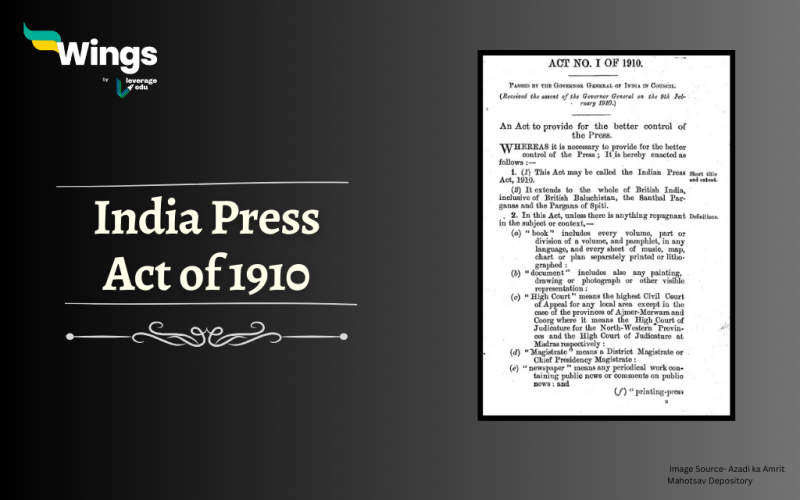The Indian Press Act 1910, came into force as a measure to curb the progress of the Swadeshi Movement. The act was in response to the worst aspects of the Vernacular Press Act (VPA). The government had the fear of growing dissent among the masses, thus the law was enacted by the British colonial government in India. It aimed to regulate the freedom of the press and control the nationalist movement. In this blog, we will learn more about this act and know the background as well as the provisions of the act.
Table of Contents
What was the background of the Indian Press Act of 1910?
The act was introduced by Lord Ridley, the then Home Minister on February 4, 1910, and was passed by Lord Minto II, the then Viceroy of India on 9th February, 1910. It granted the government extensive powers to censor and suppress publications and to prohibit the distribution of anti-government information.
The Need for Regulation
The British authorities felt threatened by the growing nationalist movement in India. The press was seen as a powerful tool for mobilizing public opinion. The Indian Press Act of 1910 was introduced to curb the influence of nationalist newspapers.
What were the Key Provisions of the Act?
Some of the important provisions of the act were –
- Censorship: The act provided the authorities with the power to censor newspapers and publications that contained seditious or objectionable content that could be suppressed. Editors had to submit their articles to the government for approval before publication.
- Penalties and Punishments: The act prescribed strict penalties for violators. Editors who published seditious materials could be fined or imprisoned and were required to deposit between Rs 500 to Rs 5000, depending on the discretion of the magistrate.
- Financial Confiscation – Publications could also be confiscated or banned if any legislation’s provisions were violated.
- Emergency Powers: The act granted the government emergency powers during times of unrest. Section 12 (1) of the act granted the power to local governments to issue any warrants against the newspaper or book if any seditious matters were published.
The act undermined the freedom of expression and curtailed the activities of nationalist publications.
Also Read: Development of Press in India
Implications and Significance of the Act
The Indian Press Act of 1910 was met with widespread opposition from Indian nationalists. It was seen as an attack on freedom of the press and a means to stifle dissent.
- The defined press offences under the bill were –
- attempts or incite murders
- tampering with the loyalty of the Army or Navy
- excite racism
- class differences or matters related to religious sentiments and animosity
- contempt of the Government or native princes
- Intimidation of public servants or
- Interference with law and order
The act further fueled the Indian national movements and contributed to the push for independence. Despite the restrictions imposed by the act, the press played a significant role and leaders continued their nationalist movement.
- Newspapers became platforms for spreading awareness and mobilizing public opinion.
- Editors and writers used their publications to criticize British rule and advocate for independence.
- Bal Gangadhar Tilak was one of the leaders who was prosecuted for sedition and was sentenced to six years of jail in Burma
Also Read – What was Wood’s Despatch?
Repeal of the Act
- Under the chairmanship of Sir Tej Bahadur Sapru, a law member of the Government of India, a committee was set to examine the consequences.
- The act was repealed on the recommendation of the Committee.
- The Indian Press Act was later abolished by Lord Reading, the Viceroy of India.
Evolution of Press Freedom in India
The licensing system was abolished, and censorship was reduced. However, powers to suppress publications in the interest of public order remained.
- The Government of India Act of 1935: Press freedom expanded further. Censorship powers were curtailed, and newspapers gained more independence. However, restrictions were still in place, particularly during wartime under the Government of India Act of 1935
- Indian Independence (1947): With independence, India guaranteed press freedom in its constitution. The right to freedom of speech and expression, including press freedom, was enshrined as a fundamental right. However, reasonable restrictions can still be imposed in the interest of public order, security, and morality under the Indian Independence Act (1947)
The Indian Press Act of 1910 was a significant event in the history of press freedom in India. It represented a deliberate effort by the British colonial government to control the nationalist movement by restricting the press. Despite its intentions, the act only served to intensify resistance and further galvanise the struggle for independence. The act was eventually repealed, and with India’s independence, press freedom was recognized as a fundamental right.
Relevant Blogs
| The Simon Commission | Lord Canning |
| Lord Ellenborough | Lord Macauley |
| Lord Hardinge 1 | Indian National Movement |
| Lord William Bentinck | Lord Dalhousie |
| Civil Disobedience Movement | Lord Minto 1 |
We hope you liked our blog. If you want to read more articles like this, you can get Short notes on the Modern History of India here. Also, you can visit our general knowledge page on Indian History!
 One app for all your study abroad needs
One app for all your study abroad needs













